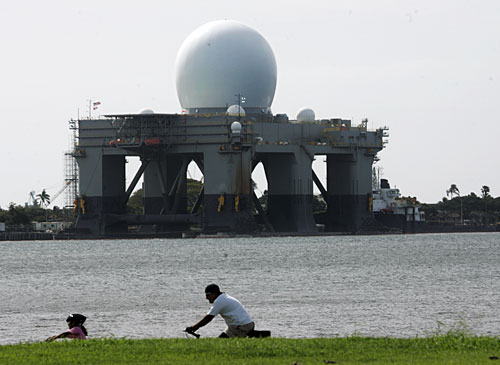January 9, 2009
Hawaii’s Pearl Harbor to become hub for new nuclear subs
Virginia-class vessels likely to mean hiring hundreds more workers
By William Cole
Advertiser Military Writer
Two-thirds of the Navy’s new Virginia-class submarines initially will be based at Pearl Harbor, making Hawai’i the main hub for the advanced attack submarines, Navy officials said yesterday.
The Navy plans to build 30 of the nuclear submarines, which cost up to $2.5 billion apiece, carry torpedoes and missiles, and can drop off commandos close to shore.
The Navy isn’t releasing the exact number or arrival schedule for subs coming to Pearl Harbor beyond the USS Hawaii, expected in late June, and the USS Texas, scheduled to arrive in late October or early November.
U.S. Sen. Daniel K. Inouye, D-Hawai’i, previously has said the USS North Carolina also will be homeported here.
The Navy revealed the Virginia-class submarine distribution information yesterday at an annual military update for the Hawai’i business community.
Capt. W. Scott Gureck, a spokesman for the U.S. Pacific Fleet, said Virginia-class submarines initially will be homeported in Groton, Conn., and at Pearl Harbor. At least four that are in active service have operated temporarily out of the East Coast.
The 2006 Quadrennial Defense Review, a 20-year planning roadmap for the military, called for 60 percent of attack submarines to be based in the Pacific and 40 percent in the Atlantic.
“The initial (Virginia-class) homeporting will indeed be at Groton and Pearl Harbor, but eventually they will be everywhere we currently have Los Angeles-class (subs),” Gureck said. “It’s just from a parts standpoint and maintenance standpoint, you don’t want to put a couple Virginias in all the locations. You want to put them where you have critical mass.”
The overall number of attack submarines at Pearl Harbor – about 15 – will not change, Gureck said. The new Virginia class will replace existing Los Angeles-class submarines as the older class reaches the end of its lifespan, he said.
The Virginia-class arrival is good news for Pearl Harbor Naval Shipyard, the state’s largest industrial employer, with 4,200 civilian workers.
About 90 percent of the yard’s work has been on the aging Los Angeles-class attack submarines, including maintenance as well as nuclear reactor refueling and defuelings.
More Shipyard jobs
Capt. Gregory Thomas, who commands the shipyard, yesterday said the switch to Virginia-class work “keeps us focused on what’s been our principal product here for the past 10 years – which is submarines.”
“It’s a very smooth transition,” Thomas said, adding that the workload should mean an increase to about 4,400 shipyard workers by 2013. The bulk of the work was non-reactor servicing, and that will continue with the Virginia subs, he said.
Northrop Grumman is producing the Virginia-class submarines in a teaming arrangement with General Dynamics Electric Boat. The Virginia class is ultimately expected to total 30 vessels.
Ten of the vessels have been delivered or were already under contract before a December award of a $14 billion contract for eight more of the submarines, according to Bloomberg News.
The contract calls for construction of one submarine in each of the years 2009 and 2010, and two per year from 2011 to 2013.
The submarines are 377 feet long and have a beam of 34 feet. They can operate at underwater speeds of more than 25 knots, dive more than 800 feet and stay submerged for up to three months at a time.
The submarines also are equipped with a lock-out chamber large enough for nine commandos, more than triple the capacity of older submarines.
Military and economy
About 270 business people attended yesterday’s military update at the Hilton Hawaiian Village by all five of the U.S. armed forces, a larger turnout than usual for the annual meeting.
The event is hosted by the Chamber of Commerce of Hawai’i. Charlie Ota, the chamber’s vice president for military affairs, said the big turnout may be tied to business looking even more to the military for contracts in tough economic times.
The military “is a relatively stable source of revenue to the economy,” Ota said.
The military, the No. 2 contributor to the state’s economy behind tourism, has been in expansion mode in Hawai’i in recent years.
Lt. Gen. Benjamin R. Mixon, commander of U.S. Army Pacific at Fort Shafter, said 10,500 soldiers and civilian workers have been added in Hawai’i.
Col. Wayne Shanks, a spokesman at the command, said that change has taken place since the late 1990s. Shanks said Schofield Barracks has about 20,000 soldiers and Fort Shafter has about 3,000.
Adm. Robert Willard, the four-star commander of the U.S. Pacific Fleet and the keynote speaker at the chamber’s luncheon following the military update, said Asia and the Pacific will remain central to U.S. interests.
He said he doesn’t expect the commitment of operating forces to diminish, even with the current economy.
U.S. Pacific Command, headquartered at Camp Smith, covers half the globe and monitors five of the biggest militaries in the world: those of the People’s Republic of China, India, Russia, North Korea and South Korea.
“There are certainly concerns that the budgets in the military will be affected by the current economic environment that we find ourselves in,” Willard said.
But he added that he believes “the readiness monies that are invested in maintaining the fleet – and the forces that exist out here – will remain.”
Source: http://www.honoluluadvertiser.com/article/20090109/NEWS01/901090361










